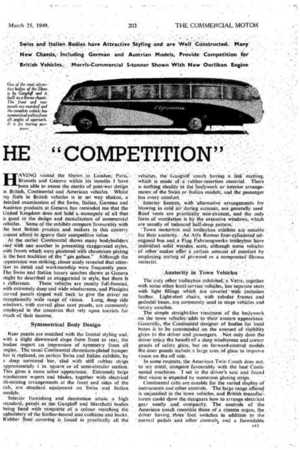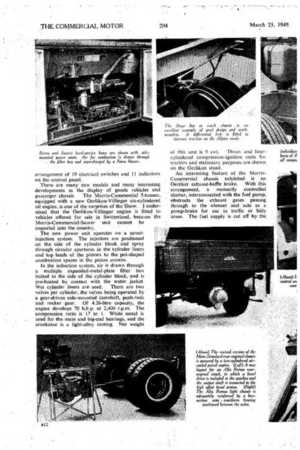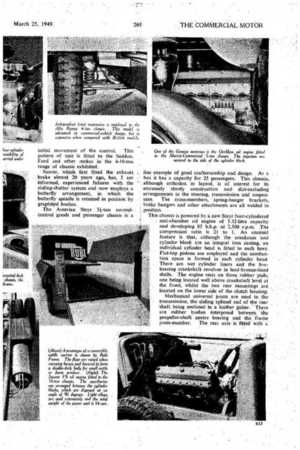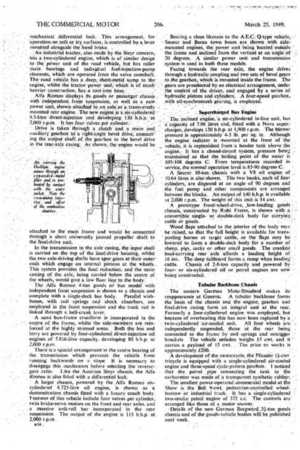GENEVA SHOV REVEAL
Page 18

Page 19

Page 20

Page 21

Page 22

If you've noticed an error in this article please click here to report it so we can fix it.
Swiss and Italian Bodies have Attractive Styling and are Well Constructed. Many New Chassis, Including German and Austrian Models, Provide Competition for British Vehicles. Morris-Commercial 5-tonner Shown With New Oerlikon Engine
AVING sited the ShoWS,Jo..1.-Ondon; Paris,
,,
H ... Brussels and Geneva within six months I have ... been able to assess the Merits of poit-ivar'design in British, Continental and American vehicles. • Whilst my faith in British vehicles" is in no way shaken, a detailed examination of the Swiss, Italian, German and Austrian products, at ..Geneva. has reminded me that the United Kingdom does not hOkl.a., monopoly of all that's good in. the deign and manufacture of commercial vehicles. Some of the exhibits compare favourably with the best British practice and Makers . in this country ,cannot affOrdto ignore ffieir coMpetitive Value. At the earlier Continental .shows many bodybuilders yield With one another In presenting exaggerated styles, with fronts which were plastered With chromium plating in the best tradition of the "gin palace." Although the ippearance was striking, closer study revealed that attention to detail, and workinanship were frequently poor. The Swiss and Italian luxury coaches shown at Geneva : might he described as exaggerated in style, but there is
a difference. These 'vehicles are mostly full-fronted, .vith extremely deep' and wide windscreens, and Plexiglas curved panels sloped, well back to give the driver an . exceptionally wide range of vision. Long, deep side windows, with curved glass cant panels, are commonly employed in the countries that rely upon tourists for mirch of their income.'
• Symmetrical Body Design Rear panels are matched with the frontal styling and, with a slight downward slope from front to rear, the bodies impart ell impressionof'symmetry from all :ingles. The usual Continental Chromium-plated bumper bar is replaced, on certain Swiss and Italian exhibits, by a deep ' surround bar, clad with stiff rubber strips approximately 1 in. -square or of semi-circular section. This gives a More Sober appearance. Extremely large windscreen wipers and blades, together with electrical de-misting arrangements at the front and sides of the cab, are standard equipment on Swiss and Italian
models.. . . '
Interior furnishing and decoration , attain a high standard,: pahels:in.die Gangioff and Marchetti bodies being lined with moquette of a colour matching the upholstery of The leather-bound:seat etishiOns and backs: Rubber floor covering is found in •practically all the
vehicles,the Clanglatf coach. having having a lihk. matting, Which is made of, a -rubber-iniertion Material. There is nothing shoddy in the bociSTwork or interior arrangements of the SwisS or Italian mOdeIs, and the passenger has every comfort.
Interior heaters, with 'alternative arrangements for blowing in Cold air during summer, are generally used Roof vents are practieally nein-existent, and the only . form of ventilation is by the extensive windows, which
are usually of balancedhalfdrop. pattern: 'Towh motorbtis and .treilleybus exhibits are notable for their austerity. An: Alfa Romeo fourLeylindered oilengined bps and a F.lug rahrzeugwerke trbileybus have individual, solid _wooden seats, although some vehicles of other 'makesOffer: a pertain amount of Comfort by eninloYing sealing of plywood or a compressed 'fibrous material.
S. Austerity -in Town Vehicles The oaiy other trolleybus exhibited; a Vetra, together • with some other local-service vehicles; has'sepaTate seats with light, fillings which are 'coveied .,Vvith• imitation leather. Light-steel chairs, with tubular' frames and pedestat bases, are commonly nsed in stage vehicles and
luxury coaches.. , .
. The simple straight.line treatment_ of -the bodywork on the town vehieles-nd_ds'to -their austere appearance. Generally, the Continental -designer of bodies for. local huSes is.. to be commended on the amount of Visibility given to the driver and passengers, Not Only does the driver enjoy the benefit of a deep windscreen and corner panels of safety glass,but on forward-control models the door panels include a large area of glass to improve vision on the offside.
In some 'respects, the American .Twin Coach does not, to my mind, cOmpare favourably with the best Conti7 nental machines. I sat in the driver's seat and found that vision is impeded by numerous .glazing strips., • • Continental cabs are notable. for.the varied display of instruments and other controls. The large range offered is unjustified in the 'town vehicles,' and British manufac-. hirers could show the designers how to arrange electrical gear .neatly .and. compactly. The, controls of the American coach resent* those of a cinema organ, the driver haVing. three"-foot. switches in additidn to the normal pedals and other controls, and a formidable
arrangement of 19 electrical switches and I 1 indicators on the control panel.
There are many new models and many interesting developments in the display of goods vehicles and passenger chassis The Morris-Commercial 5-tonner, equipped with a new Oerlikon-Villinger six-cylindered oil engine, is one of the surprises of the Show. I understand that the Oerlikon-Villinger engine is fitted to vehicles offered for sale in Switzerland, because the Morris-Commercial-Saurer unit cannot be imported into the country.
The new power unit operates on a affectinjection system. The injectors are positioned on the side of the cylinder block and spray through circular apertures in the 'cylinder, liners and top lands of the pistons to the pot-shaped combustion spaces in the piston crowns.
In the induction system, air is drawn through a multiple expanded-metal-plate filter box -bolted to the side of the cylinder block, and is pre-heated by contact with the water jacket.
Wet cylinder liners are, used. There are two valves per cylinder, the valves being operated by a gear-driven side-mounted camshaft, push-rods
and, rocker gear. Of 4.26-litre capacity, the engine develops 70 b.h.p. at 2,400 r.p.m. The compression ratio is 17 to I. White metal is used for the main and big-end bearings, and the crankcase is a light-alloy casting. Net weight
of this unit is 9 cwt. Threeand four
cylindered compression-ignition units for tractors and stationary purposes are shown on the Oerlikon stand.
An interesting feature of the MorrisCommercial chassis exhibited is an Oertiker exhaust-baffle brake. With this arrangement, a manually controlled shutter, interconnected with the fuel pump, obstructs the exhaust gases passing through to the silencer :and acts as a pump-brake for use in traffic or hilly areas. The -fuel supply is cut off by the.
initial movement of the control. This pattern of unit is fitted to the Seddon. Ford and other makes in the 4-10-ton range of chassis exhibited.
Saurer, which first fitted the exhaust brake almost 20 years ago, has, I am informed, experienced failures with the sliding-shutter system and now employs a butterfly arrangement, in which the butterfly spindle is retained in position by graphited bushes.
The Austrian Steyr 3i-ton normalcontrol goods and passenger chassis is a fine example of good craftsmanship and design. As a bus it has a capacity for 25 passengers. This chassis, although orthodox in layout, is of interest for its extremely sturdy construction and dirt-excluding arrangements in the steering, transmission and suspen sion. The cross-members, ' spring-hanger brackets, brake hangers and other attachments are all welded in , position.
This chassis•is powered by a new Steyr four-cylindered anti-chamber oil engine of 5.32-litre capacity and developing 85 b.h.p, at 2,300 r.p.m. ,The compression ratio. is 21 to 1. An unusual feature is that, although the crankcase and cylinder block are an integral iron casting, an individual cylinder head is fitted to each bore. Flat-top pistons are employed and the combustion space is formed in each cylinder head. There are wet cylinder liners and the fivebearing crankshaft revolves in lead-bronze-lined shells. The engine rests on three rubber pads, one being located well above crankshaft level at the front, whilst the two rear mountings are ., located on the lower side of the clutch housing.
Mechanical universal joints are used in the transmission, the sliding splined end of the rear , 'shaft being enclosed in a leather gaiter. " There are rubber bushes interposed between —the propeller-shaft centre bearing and the frame cross-member. The rear axle is...fitted. with a
mechanical differential lock. This arrangement, for • Operationon Soft or icy surfaces, is controlled by a, lever mounted alongside the hand brake.
• .An iridustrial tractor, also made by the Steyr concern, has a twoLcylindered engine, which is of similar design to the pciwer unit of the road vehicle, but has roller main bearings and individual fuel-injection-pump • elements, which are operated from the valve camshaft. The road vehicle has a :deep, sheetainetal sump to the engine, whilst the 'tractor power unit, which is Of much heavier construction, has a cast-iron base.
• Alfa Romeo displays its goods-, or passenger chassis with .independent front Suspension, as welt. as. a new power unit, shown attached to an axle as a.transversely mounted rear engine. The newengine is •A. six eyfincie red • 9.5-litre direct-injection unit deVeloping 130 b.h.p. ;at 2,000 r.p.m. It has four Valves; per cylinder. Drive is taken through a clutch and a _Main and • auxiliary gearbox' to a right-angle bevel drive, cOrinect= ing the output shaft of the gearbox to the bevel drive in the rear-axle casing. As shown, the engine wciuld be attached to the main frame and would be connected through .a short universally jointed propeller shaft to
the final-drive unit. • .
in the transmission to the axle casing, the input shaft is carried on the top of the final-drive housing, whilst the two axle-driving shafts have Spur gears at their outer. ends which engage on internal pinions at the wheels. This system provides the final reduction, and the main casting of the axle, being carded 'below the centre of the wheels, would give a low floor line to the body:
The Alfa Romeo •4-ton goods or bps model with independent front suspension is shown as a chassis and complete with a single-deck• bus body. , Parallel wishbones, with coil springs . and shock absorbers, are 'employed in the front suspension and the track rod is linked through a. bell-crank lever.
-A ,semi box-frame cruciform is incorporated in the centre of the frame, whilst the side-members are reinforced at the highly stressed areas. Both the bus and lorry arc powered by four-cylindered direct-injection' oil engines of 5.816-litre capacity. developing 80 b.h.p. at 2,000 rpm.
There is a special arrangement in the centre bearing of the transmission which prevents the vehicle from running backwards on a slope It is necessary to -disengage -this mechanism before selecting the reverse
gear .ratio. Like the Austrian Steyr chassis, the Alfa Romeo is also fitted with a differential lock.
A larger chassis, powered by the Alfa Romeo sixcyiindered 8.725-litre oil engine, is shown as a demonstration chassis fitted with a luxury coach body. 1-.e.attires of this vehicle include four valves per cylinder, twin brake-servo motors on the front and rear axles, and a . massive anti-roll bar incorporated in the rear suspension, The output of the engine is 115 b.h.p. at 2,000 r.p.m Bearing a close likeness to the A.E.C. Q-type vehicle, Saurcr and Beata town buses aye shown with side-mounted engines, the power unit being located outside the frame and inclined from the vertical at an angle of 20 degrees. A similar power unit and transmission system is used in both these models.
Facing towards the rear axle, the engine drives through a hydraulic coupling and two sets of bevel gears to the gearbox, which is mounted inside the frame. The gears are preselected-by an electrical arrangement, under the control of the driver, and engaged by a series of hydraulic pistons and cylinders. A four-speed gearbox, with all-synchromesh gearing, is employed.
Supercharged Bus Engine The, inclined engine, a six-cylindered in-line unit, has
capacity of 7.98 litres and, fitted_ with a Nova supercharger, develops 120 b.h.p. at 1,900 r.p.m. The blower pressure is approximately 4-5 lb. per sq. in. Although the engine radiator is mounted at the front of the vehicle, it is -replenished from -a header tank above the engine.: It has a closed-circuit system, pressure being maintained so that the boiling point of the water is 105-108 degrees C. From temperatures recorded in service, the normal operation level is 85-90 degrees C.
A .Saurer 10-ton chassis with a V8 oil engine of 10.64 litres is also shown. The two banks, each of four cylinders, are disposed at an angle of 90 degrees and the fuel pump and other components are arranged between the blocks. An output of 140 b.h.p. is available at 2,000 r.p.m. The weight of this unit is 14 cwt.
A prototype front-wheel-drive, ,low-loading goods chassis, constructed by Rubi Freres, is shown with a convertible singleor double-deck body for carrying cattle or goods.
Wood flaps attached to the interior of the body ma he raised, so that the full height is available for transporting horses or larger cattle, or the flaps may be lowered to form a double-deck body for a number of sheep, pigs, sacks or other small goods. The cranked load-carrying rear axle affords a loading height of 16 ins. The deep tailboard forms a ramp when loading . cattle. Chassis of 2-8-ton capacity and powered by fouror six-cylindered oil or petrol engines are now being constructed.
Tubular Backbone .Chassis
The austere German Moto-Standard makes its leappearance at Geneva, A tubular backbone forms (he basis of the chassis and the engine, gearbox and final-drive casing form an integral unit at the rear. Formerly a four-cylindered engine was employed, but because of overheating this has now been replaced by a twin-cylindered air-cooled unit. All four wheels are . independently suspended, those at (he rear being . connected to the frame by coil springs and outrigger brackets The vehicle unladen weighs 15 cwt. and it carries a payload of 15 cwt. The price ex works is approximately £200.
A development of the motorcycle, the Pfander li-cwt tricycle is equipped with a single-cylindered air-cooled engine and three-speed cycle-pattern gearbox. 1 noticed that the petrol pipe connecting the tank to the carburetter was made of a transparent synthetic rubber:
The smallest power-operated commercial model at the Show is the Bell 9-cwt. pedestrian-controlled wheelbarrow or industrial truck -lt has a single-cylindered two-stroke petrol engine of 172 c.c. The controls are arranged like those of a motor mower.
Details of the new German Borgward-.31-ton goods chassis and of the goods-vehicle bodies will be published next week.


























